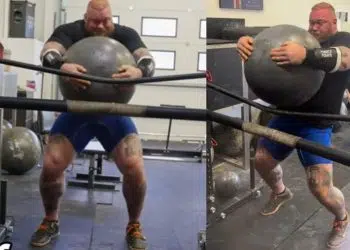When it comes to choosing the right workout, you might be deciding between circuit training or cross training. Circuit training targets various muscle groups through a series of cardio and resistance exercises, providing a thorough workout. Meanwhile, cross training varies your routine with different exercises and activities, ensuring a balanced approach to fitness.
So, for example, if you want to build muscle, your focus should be bodybuilding-style workouts. Alternatively, if you want to develop fitness and endurance, cardio is the way to go.
But what about circuit training and cross training? What needs and goals are they designed to meet?
As a 30-year veteran personal trainer, part of my job is investigating different training methods so I can pick the best options for my army of clients. Think of me as a workout matchmaker! As such, I’m ideally equipped to help you choose between these two popular, effective training methods.
In this article, I compare and contrast circuit training vs. cross training so you can pick the one that’s right for you.
What is Circuit Training?
Level Up Your Fitness: Join our 💪 strong community in Fitness Volt Newsletter. Get daily inspiration, expert-backed workouts, nutrition tips, the latest in strength sports, and the support you need to reach your goals. Subscribe for free!
Like most popular workouts, circuit training has been around for many years. Most resources suggest that circuit training was invented in the early 1950s by R.E. Morgan and G.T. Anderson at the University of Leeds, England (1). However, it’s likely that circuit training is much older than this and may have even been practiced in ancient Greece and Rome.
But what is circuit training? Let’s dive in and discuss!
Circuit training is a type of workout where several exercises are done back-to-back. Participants have little or no rest between exercises, which are known as stations in circuit training parlance. A circuit can comprise as few as six and as many as 12-15 exercises, but 8-10 is the norm.
Exercises are typically performed for time or repetitions and involve bodyweight, resistance machine, freeweight, or resistance bands. Some circuits involve multiple exercise modalities.
You’ll find circuit training classes in most gyms, and they’re also ideal for home workouts.
Never tried circuit training? Here is an example workout to try. Feel free to adjust the reps and rest periods to match your abilities and experience.
- Air squats x 20
- Push-ups x 10
- Jump rope x 50
- Lunges x 10 per leg
- Inverted rows x 10
- Planks x 30 seconds
- Bench dips x 10
- Step-ups x 15 per leg
- Bent-knee sit-ups x 15
- Jumping jacks x 20
Move as quickly as possible between exercises, and rest for 1-2 minutes between rounds. Complete 2-4 rounds in total.
Circuit Training Advantages and Benefits
Not sure if circuit training is the right workout for you? Consider these science-backed benefits and then decide (2)!
Improved cardiovascular fitness – despite being a resistance training-based workout, circuit training will enhance your cardiovascular fitness. That’s because doing several back-to-back exercises raises your heart and breathing rate, just like traditional cardio. As such, we can class circuit training as a form of HIIT or high-intensity interval training.
Improved muscular fitness – depending on the exercises and loads used, you can use circuit training to build muscle strength, power, endurance, or size. In fact, you can combine training methods to develop all of these characteristics simultaneously.
However, it’s worth noting that while circuit training will improve strength, power, etc., you’ll probably experience better results from more specialized training routines.
Fat burning and weight loss – the precise number of kilocalories burned during circuit training depends on the duration and intensity of your workout. That said, the non-stop nature of this workout means it has the potential to burn more kilocalories than slower-paced programs.
Related: How Many Kilocalories Do You Burn Doing Circuit Training?
Time-efficient workout – most conventional resistance-based workouts involve more rest than exercise time. As such, you’ll spend most of your session recovering between sets of each exercise. Circuit training involves fewer rests, which makes it much more time-efficient. A well-designed circuit will work every major muscle group in 30-40 minutes.
In addition, because circuit training improves cardiovascular and muscular fitness simultaneously, you won’t need so many workouts per week. Consequently, you should be able to develop a high level of all-around fitness and conditioning in three workouts per week.

Modifiable to your needs and goals – circuit training can be as easy or as hard as you want. Workout characteristics you can adjust include:
- Exercise difficulty
- Load
- Number of reps/time per exercise
- Rest between exercises
- Rest between rounds
- Number of rounds
Consequently, you can modify circuit training to meet virtually any fitness level and training goal. In addition, you can adapt this workout to match your training environment and the equipment you have available. You can even get an excellent circuit workout using nothing but bodyweight exercises.
Variable and fun – you can mix and match exercises to create an unlimited number of circuit workouts. This can help enhance motivation, consistency, and enjoyment. If you get bored during conventional workouts, circuit training could provide the variety you crave.
What is Cross Training?
Where circuit training is a type of workout, cross training is more of a training philosophy. Originally used by athletes to avoid off-season burnout, cross training involves doing different workouts throughout the week to create a good level of all-around fitness and conditioning.
For example, a week of general fitness cross training could look something like this:
- Monday – full-body strength training
- Tuesday – easy-moderate cardio session
- Wednesday – yoga/Pilates class
- Thursday – full-body strength training
- Friday – cardio interval training
- Saturday – hiking/biking
- Sunday – rest/stretching
As you can see, the program involves a range of activities that, performed regularly, should improve all types of fitness, including strength, cardiovascular, and flexibility/mobility.
Hybrid training is a variation of cross training. It’s a little more structured and designed to produce significant improvements in strength and cardiovascular fitness. However, the principles are very similar.
Level Up Your Fitness: Join our 💪 strong community in Fitness Volt Newsletter. Get daily inspiration, expert-backed workouts, nutrition tips, the latest in strength sports, and the support you need to reach your goals. Subscribe for free!
You can learn more about hybrid training in this in-depth guide.
CrossFit is another form of cross training. Workouts are varied and involve many different types of exercise, such as powerlifting, weightlifting, gymnastics, and cardio. However, CrossFit workouts are usually very intense and may not suit everyone.
Cross Training Advantages and Benefits
Is cross training the best way to organize your workouts? Consider these research-backed benefits and then decide (3)!
Fewer overuse injuries – chronic overuse injuries are common in exercisers who do the same type of workout all the time. Runners often suffer knee and hip issues, while lifters may experience shoulder and elbow pain.
Cross training allows you to spread the stress of working out across more joints and muscles, which may help reduce your risk of developing unwanted aches and pains.
Lower risk of overtraining and burnout – doing the same type of training over and over can cause physical and emotional burnout. That’s especially true if you always train at maximum intensity. Cross training involves doing different workouts on different days, which can help promote recovery and prevent overtraining.
Develop better all-around fitness – runners typically have great cardiovascular fitness but tend to lack strength. In contrast, lifters are usually very strong but are not so fit. Cross training means you can develop all fitness components equally.
However, if you want to emphasize one type of fitness over another, you will get better results by specializing in the workout that best matches your needs and goals.

More enjoyable workouts – some exercisers find repeating the same workouts boring. The varied weekly plan of cross training means you’ll never do the same workout two days in a row. Many exercisers enjoy such a varied approach.
Address your fitness imbalances – you can design your cross-training week to reflect your personal fitness needs. For example, if you wanted to emphasize cardiovascular fitness while maintaining strength, your workout week could look like this:
- Monday – 90-minute LISS/Zone 2 bike ride
- Tuesday – 60-minute Fartlek run
- Wednesday – full-body strength training
- Thursday – Yoga/stretch
- Friday – 60-minute easy run
- Saturday – full-body strength training
- Sunday – 40-minute interval swim
Ultimately, you can create your weekly plan based entirely on your fitness needs and wants, altering it as your goals change and your conditioning improves.
In many cases, exercisers change their cross training plan according to competitive seasons, following a general approach in the off-season, and being more sports-specific as competition time approaches.
Circuit Training vs. Cross Training: FAQs
Do you have a question about circuit training vs. cross training? No problem! I’ve got extensive experience with both methods and have the answers you need. But if you want more information, please drop me a line in the comments section below, and I’ll get back to you ASAP.
1. Which is best for fat burning and weight loss – circuit or cross training?
Circuit and cross training can help you burn fat and lose weight. Circuit training burns a lot of kilocalories per workout. In contrast, you can organize your cross-training week to emphasize fat-burning.
However, the real trick to losing fat is consuming fewer kilocalories to create an energy deficit. This is arguably the most important thing you need to do to shed those unwanted pounds.
2. Will circuit or cross training build more muscle?
Provided you challenge your muscles with appropriate exercises, sufficient intensity, and enough volume, circuit and cross training can result in muscle growth. However, these are by-products rather than the aim of these training methods.
If you are serious about maximizing muscle size, you’ll be better off following a bodybuilding-type workout. Check out our workout archives to find your next bodybuilding program.
3. Which type of training is the most time-efficient?
Cross training invariably involves 4-6 (or more) workouts per week. However, the actual number of sessions will depend on your experience, needs, and goals. As such, cross training can be quite time-consuming.
In contrast, circuit workouts tend to be short and intense. Consequently, you probably won’t want to do them so often. In most cases, I recommend no more than three circuit training sessions a week. Therefore, circuit training is the most time-efficient approach.
4. Are circuit and cross training safe?
Any workout is safe if you adapt it to meet your experience and abilities. Injuries and health issues are invariably the result of trying to do too much too soon or using poor exercise technique.
Provided you don’t break these guidelines, both circuit and cross training are very safe. However, there is a small risk with any type of workout, so listen to your body and exercise your common sense alongside your muscles. Stop your workout if you feel pain or are unwell. Get expert guidance if you are unsure how to do your chosen workout properly.
5. Are these methods suitable for beginners?
One of the great things about circuit and cross training is that they are easy to modify for all fitness levels – from complete beginner to elite Olympian. In the case of circuit training, you can make your workout easier or harder by changing the exercise variables, e.g., movement complexity, intensity, and number of reps and rounds.
In contrast, you can modify cross training by adjusting the difficulty of each workout and varying training duration and frequency.
Both circuit and cross training can grow as you get fitter. As such, you should be able to keep using these methods for many years to come.
Closing Thoughts
I’ve done a lot of circuit and cross training during my sporting and professional career. I was introduced to circuit training as a young long jumper, and it’s long been a cornerstone of my strength and conditioning workouts. Similarly, as a semi-pro triathlete, cross training was part and parcel of my preparation for races.
As a personal trainer with over 30 years of experience, I often use circuit and cross training with my clients. They’re potent tools I can adapt to meet almost any fitness goal.
That said, circuit training and cross training are very different. Where circuit training is a type of workout, cross training is more of an exercise philosophy. In fact, you can even include circuit training in a cross-training plan!
However, it’s important to understand that while circuit and cross training are ideal for developing general all-around fitness, they’re less helpful in improving specific fitness components.
So, if you want to maximize muscle growth or run the fastest possible marathon, you should follow a program designed to meet those goals. But, if you want to be a fitness jack-of-all-trades, both circuit and cross training can help.
References:
- University of New Mexico: New Insights into Circuit Training, Len Kravitz, Ph.D.
- Muñoz-Martínez FA, Rubio-Arias JÁ, Ramos-Campo DJ, Alcaraz PE. Effectiveness of Resistance Circuit-Based Training for Maximum Oxygen Uptake and Upper-Body One-Repetition Maximum Improvements: A Systematic Review and Meta-Analysis. Sports Med. 2017 Dec;47(12):2553-2568. doi: 10.1007/s40279-017-0773-4. PMID: 28822112.
- Tanaka H. Effects of cross-training. Transfer of training effects on VO2max between cycling, running, and swimming. Sports Med. 1994 Nov;18(5):330-9. doi: 10.2165/00007256-199418050-00005. PMID: 7871294.
Article Updates Timeline:
Our editorial team experts constantly update the articles with new information & research, ensuring you always have access to the latest and most reliable information.
February 10, 2024
Written By
Patrick Dale, PT, ex-Marine
Updated By
Tom Miller, CSCS
Reviewed By
Editorial Team













